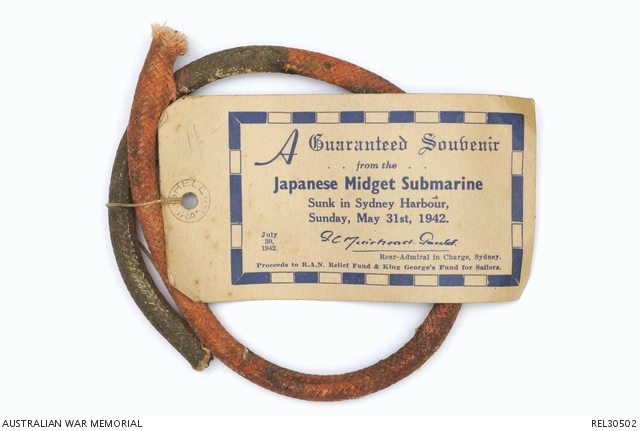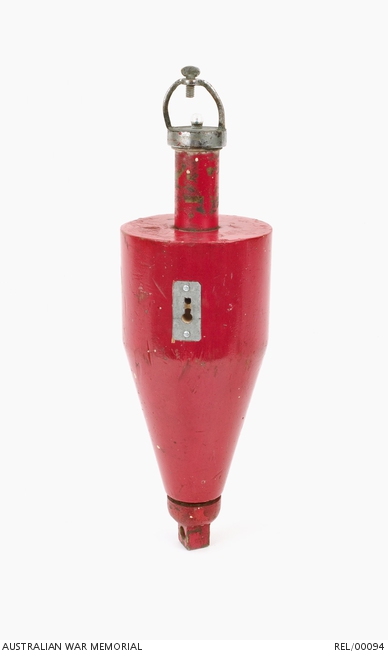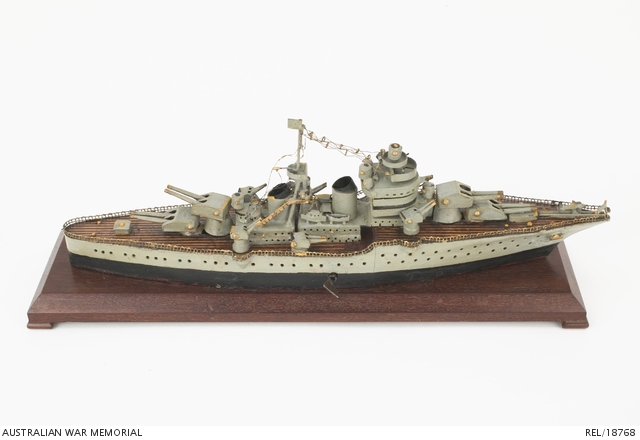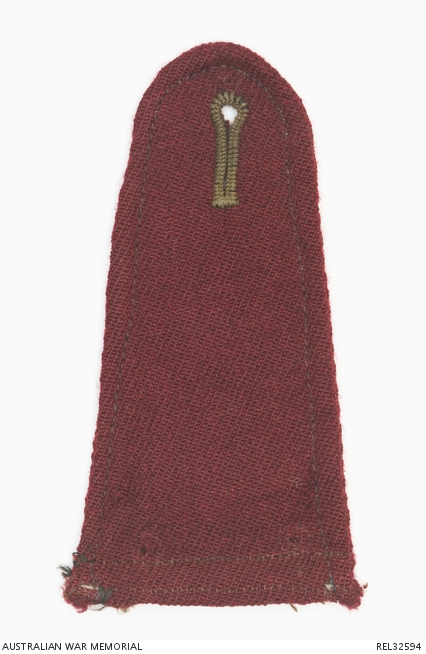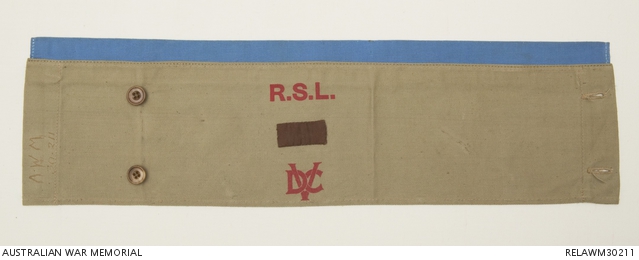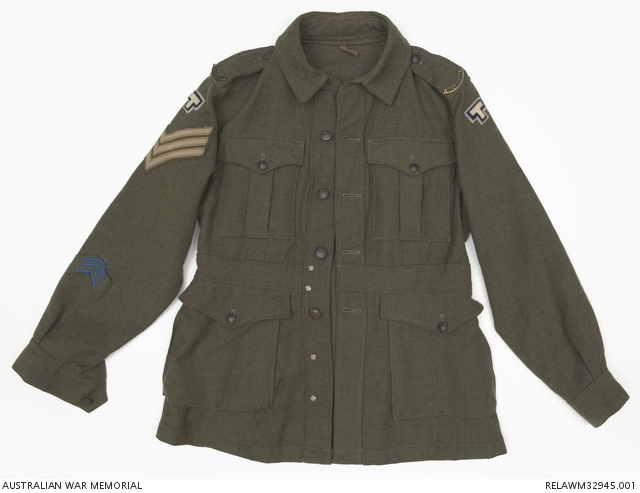Australia under attack: Exhibition items - objects
Exhibition items - objects
Japanese paratrooper’s rifle, bayonet and flag
Japanese paratroops were used in the invasion of Java and Dutch Timor in 1942. This 7.7-millimetre calibre Arisaka rifle is the product of lessons learned in those battles. It disassembles so that it can be carried more easily by highly trained airborne assault troops. Australians feared paratroopers using these weapons would land in Australia. Former soldier Colin Nowland, of Melbourne, remembered the wild stories that circulated as Japanese bombs fell on Darwin: “a rumour went round that the [Japanese] paratroopers had landed at Night Cliffs”.
Japanese bomb fragment
During the air raid, the hospital ship Manunda received a direct hit and a near miss that killed more than a dozen people, including a nurse, and wounded 47 others. Despite the damage, Manunda continued to function as a hospital ship and her crew rescued survivors from other vessels. After the raid a ship’s officer found this piece of shrapnel from a Japanese bomb embedded in a freezer door in the ship’s hold. Manunda had been on its way to Singapore but was in Darwin awaiting new orders.
HMAS Lithgow tally band
This is the tally band from the cap of Leading Stoker James Brush, from Victoria. He served in HMAS Lithgow when it sank the Japanese submarine I-124, and fought gallantly in Darwin Harbour during the raids, engaging enemy aircraft and plucking survivors of damaged vessels from the sea.
Midget submarine souvenirs - model
Midget submarine souvenirs - brass pipe with label
Midget submarine souvenirs - electrical cable with label
Warning sign
An ARP team in Sydney used signs like this at the time of the attack by Japanese submarines.
Life raft distress float light
Lieutenant Colonel Leslie Outridge, of Gympie, Queensland, the 42-year-old commander of 2/2nd Casualty Clearing Station, was the only surviving doctor from the Centaur after it was torpedoed. He kept this light as a souvenir of his ordeal.
Scalpel and tweezers
Frank Reid, the ship’s chief butcher, used these instruments, from the medical kit of a life raft off the Centaur, to treat injured survivors as they waited for rescue.
Scissors
Frank Reid, the ship’s chief butcher, used these instruments, from the medical kit of a life raft off the Centaur, to treat injured survivors as they waited for rescue.
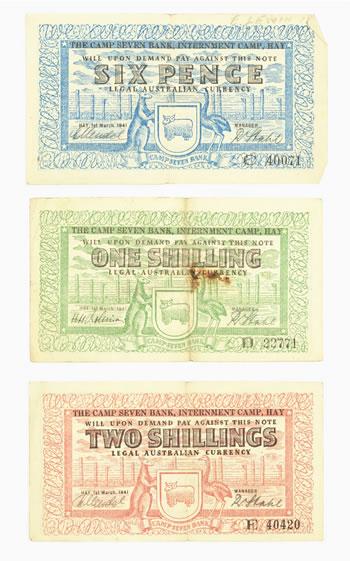
Designed by German internee and artist George Teltscher, these notes were made and used at No. 7 Internment Camp at Hay in central New South Wales. The 25 sheep represent the camp’s 25 huts. Camp leader W. Eppenstein’s name is written within the fleece of the sheep on the shield, and the names of the hut leaders on the other sheep. The barbed wire design around the edge reads, “we are here because we are here because we are here”.
Caricature of Major Edward Smythe, MC and bar
This cut-out was made for Smythe in 1942 by an Italian prisoner of war. Smythe served as a captain in the 24th Battalion during the First World War, and was awarded the Military Cross twice and mentioned in despatches. He enlisted at the outbreak of the Second World War and served as a company commander in garrison battalions at the prisoner-of-war camps at Cowra and later at Hay.
Model of a Japanese warship
Major Gordon Whitehill, an officer on the staff of the internment and prisoner-of-war camp at Loveday, in South Australia, was given this model by an unknown Japanese prisoner. The model is made from scraps of wood and flywire. Turning the key on the hull traverses the guns. Whitehill, a veteran of the first AIF, served at Loveday from 1943 to 1944.
Shoulder strap from internee uniform
Dr William Read, a First World War veteran and local air raid warden, made and used these 12 model buildings to plan ARP exercises. They represent buildings from a section of the northern Sydney suburb of Wahroonga. Dr Read’s daughter, Margaret, recalled: “He used these to play ‘war games’ with his fellow wardens and had them set up on the verandah of his home at Cleveland Street, Wahroonga.”
Enemy Raids Precautions Services badge, c. 1942
This badge indicated that the wearer was a trained volunteer with the ARP organisation in Canberra. Official historian, and later Governor-General, Sir Paul Hasluck, wrote that the federal parliament had “an expectation, almost a certainty, that Canberra would be bombed, perhaps occupied”.
Armbands worn by the State Emergency Services in Victoria
In the event of an air raid, trained volunteers would work in teams to identify the type of attack, ensure the population had taken cover, manage rescue, fire control, communications, and, in the event of a chemical attack, decontamination. Wearing armbands identified team members with specialist tasks.
ARP lapel badges
These badges were worn by volunteers from the State Emergency Services branch of Bentley in Melbourne. Each badge identified a trained volunteer with specialist skills in dealing with enforcing air raid precautions and managing the casualty evacuation, fire control and other necessities of the aftermath of an air attack.
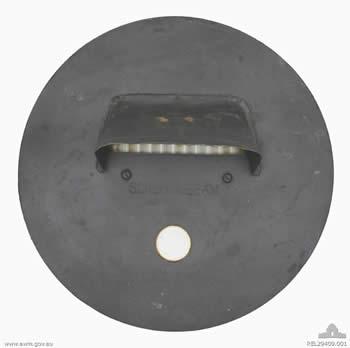
Screen-A-Beam headlight masks
In Britain during the Blitz the restrictions on showing light were called the “blackout”. In Australia more relaxed regulations led to the Australian air raid precautions being dubbed the “brownout”. These shields limited the amount of light emitted by a vehicle. To drive at night without them was an offence; however, the increase in road accidents led to the removal of headlight masks everywhere in Australia south of Rockhampton from 15 February 1943.
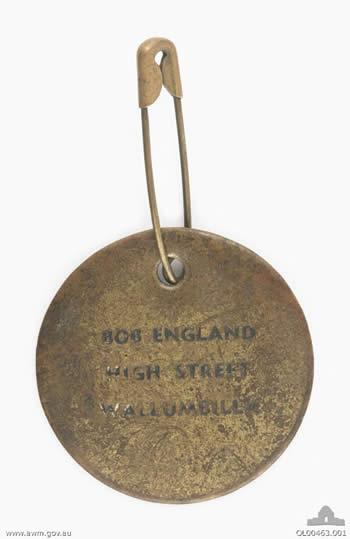
George Witt, a 63-year-old Queensland Railways guard at Roma, made identity discs for his grandchildren. One of his grandsons, Bob England, remembers his mother “kept this tag pinned to my underclothes until the threat of invasion had passed”.
Identity disc
Sir Hudson Fysh, Great War veteran and the founder of Qantas, had this disc made for his teenage son John. On one side it records John’s home address in Double Bay, Sydney, and his religion; on the other his school, Geelong Grammar in Victoria. “I don’t recall my father giving it to me, but I do recall the panic that inspired it.” He also recalled that many residents decided to move away from the immediate Sydney coastline, which “inspired my father, who had been at Gallipoli, to dub it (with some distaste) ‘The Great Retreat’”. John enlisted in the RAAF in 1944, just after his 18th birthday.
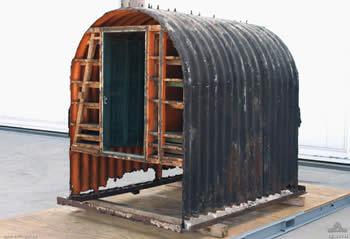
This Anderson shelter cost the Adams family £15 11s 6d. In comparison, an Australian soldier received £2 2s every week.
ARP warden’s helmet
Vincent Ronald Exton wore this helmet as the local Air Raid Precautions (ARP) Chief Warden for Ashfield in Sydney. Telephones were relatively rare at the time. His daughter, Jennifer, recalls that their telephone was protected by sandbags because of the importance of his position: “We had an air raid shelter in the backyard – a 6-foot [1.8-metre] concrete pipe partly buried, and I had the job of pumping the water out after rain. This shelter was shared with another family.”
National Emergency Services whistle
This whistle was used by National Emergency Services wardens when Australia was under attack.
Air raid warden’s rattle
This wooden rattle produces a series of very loud and distinctive clicks when spun. It was issued to wardens to warn people during air raids.
Spotter’s chair
This adjustable reclining chair was used by aircraft spotters, who were stationed around all major cities and industrial centres.
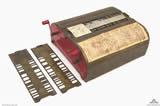
Ration calculator prototype
Australia's armed forces also sought out methods of saving money and resources. This calculator, invented by Staff Sergeant George Pearson, assisted the user to estimate quantity and type of rations required to feed a given number of people. Dr Fitzpatrick of the Army Inventions Directorate described the calculator “as a kind of ready reckoner [which] enabled a quarter of the number of clerks to do the same number of calculations and with greater accuracy”. He advised that if the army ordered twenty machines they would generate an annual saving of £16,400 ($800,000 in today’s money).
Electrolux Model C gas producer unit
Petrol was very scarce and heavily rationed. This gas producer was attached to the back of medium-sized family cars. It used charcoal to produce gas that could be used as a substitute fuel in conventional cars. The Electrolux factory in Melbourne also manufactured a larger unit for trucks and a smaller one for lighter cars.
Cigarettes
While smoking was a common habit at the time, tobacco was very scarce during the war, and cigarettes were a highly prized luxury item – and useful as something to trade.
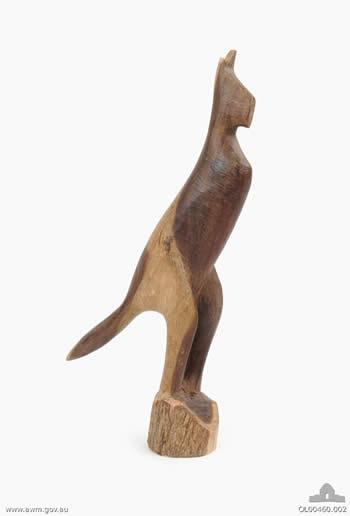
Flight Lieutenant Harold Venning, No. 14 Squadron, RAAF, of Youanmi, Western Australia, purchased carved kangaroos for his son and daughter from Aboriginal artisans on the Nullarbor Plain. He was heading home on leave aboard a Perth-bound troop train when it stopped to take on water. By 1943 children’s toys were very scarce.During his leave Harold spent time on the south coast of Western Australia with his wife Eileen and their two children, Lorraine and Keith. Originally from the goldfields, Eileen and the children had agreed to live with Harold’s parents in the south-west while he was serving in the RAAF.
Helping mothers manage in austerity, the Country Women’s Association of Queensland mounted an exhibition in Brisbane in 1943 to demonstrate that household items, such as these toys, baby booties and apron, could be made from material readily available without coupons.
Helping mothers manage in austerity, the Country Women’s Association of Queensland mounted an exhibition in Brisbane in 1943 to demonstrate that household items, such as these toys, baby booties and apron, could be made from material readily available without coupons.
Helping mothers manage in austerity, the Country Women’s Association of Queensland mounted an exhibition in Brisbane in 1943 to demonstrate that household items, such as these toys, baby booties and apron, could be made from material readily available without coupons.
War Savings Certificates banner
Gordon Binns, manager of the Victorian State Savings Bank at Cobram, raised this banner to encourage his customers to support the government’s war efforts by purchasing War Savings Certificates.
War Savings Certificate
This is one of the War Savings Certificates purchased by Douglas Adams of Sydney for his brother Fred as a Christmas gift. He noted in his diary on Wednesday 24 December 1941 that it cost “16/- [16 shillings] which will be worth one pound [20 shillings] in seven years time … I wanted a couple of certificates for myself, as they make good mementoes of this war.”
.380 calibre revolver
As part of the war effort, companies such as the Howard Auto Cultivator (HAC) Company changed from making agricultural machinery to producing weapons. The HAC revolver project was caught in competition with the Owen gun for resources. As a result, only a few hundred examples had been made when production was discontinued. Few were issued to the troops.
Owen sub-machine gun and bayonet
The Mk II Owen sub-machine gun was a development of the one designed by Evelyn Owen of Wollongong. It was championed by the Australian steel manufacturer Lysaght of Port Kembla. Owen’s gun was ideal for Australian troops fighting in New Guinea. It was cheaper and lighter than the US Thompson sub-machine gun and more robust under jungle conditions than the British Sten. Lysaght also made the unique but impractical bayonet.
Sentinel tank model
Henry Lawton, an engineer with the Armoured Fighting Vehicles Section at Fisherman’s Bend in Melbourne, made this model of the Australian cruiser tank, named the Sentinel. Australian industry did not have the capacity to bend armour plate of the type required by a cruiser tank and so the Sentinel’s makers took the revolutionary step of casting the hull. The Sentinel was a powerful weapon; unfortunately, it did not see action, as Australian armoured units were supplied with US equipment before it could be put into production.
Booby trap switch
Major Cyril Murray of North Brighton in Melbourne invented this booby trap switch. The Army Inventions Directorate was impressed by the device, and after some development it entered service with Australian forces operating in New Guinea in 1943. Eventually, in October 1950, Murray received a reward of £1,000 (almost $50,000 today) for his invention.
Fire officer’s helmet
The massive increase in demand for explosives and ammunition caused by the war led to the creation of dozens of factories and hundreds of annexes attached to existing factories. Maribyrnong, established before the First World War, remained the main producer of military explosives in Australia. This helmet was worn by one of the fire officers at the factory, an unenviable position.
Wartime lapel badges
This framed collection of badges issued by the Department of Defence and other government authorities provided a specimen example of each. These badges identified the war-related task of the wearer and often prevented them from being criticised for not being in uniform. The collection was issued during the war, and so no end date is given.
Civil Constructional Corps badge
The CCC badge could be worn on hat, lapel or overalls.
A flyer shot down over New Guinea would have found in his RAAF Emergency Flying Ration pack items essential to his survival, such as water sterilisation tablets for purifying contaminated water and Bell’s waterproof matches. As a small luxury, Wrigley’s supplied mini chewing gum packs.
A flyer shot down over New Guinea would have found in his RAAF Emergency Flying Ration pack items essential to his survival, such as water sterilisation tablets for purifying contaminated water and Bell’s waterproof matches. As a small luxury, Wrigley’s supplied mini chewing gum packs.
A flyer shot down over New Guinea would have found in his RAAF Emergency Flying Ration pack items essential to his survival, such as water sterilisation tablets for purifying contaminated water and Bell’s waterproof matches. As a small luxury, Wrigley’s supplied mini chewing gum packs.
AMF Operational Ration
This ration pack was developed by Sir Stanton Hicks. It contained three meals, each waterproofed (a vital consideration for the tropics), which offered a balanced selection of meat, vegetables, fruit and vitamin supplements. Before the development of this ration pack, Australian soldiers were supplied with quantities of preserved food that were difficult for a man to carry and divide, and which often did not provide a nourishing diet.
Camouflage paint sample swatches
These paint samples provided standard colours for the AMF to use in disguising equipment and buildings against enemy attack. Australian official war artist Frank Hinder worked with the Camouflage Wing, Royal Australian Engineers, to develop this range of standard colours. The names reflect this development: for example, basalt red, Darwin stone, scrub green, and salt grey.
German light machine-gun used by the VDC
This MG08/15 Maxim machine-gun was one of thousands of First World War souvenirs bought back to Australia. When invasion threatened in 1942 it was pressed back into service; converted to use Australian .303-inch ammunition, it was issued to the VDC.
VDC tunic
This tunic was worn by Lieutenant Wilfred Bateman from Mount Burr, South Australia. British-born Bateman served with the 9th (South Australian) Battalion, VDC, from May 1942. This green uniform was unique to the VDC in 1942 and 1943. Later in the war, they were issued with standard AIF service dress uniforms but continued to wear the distinctive circular VDC colour patch.

VDC slouch hat
The slouch hat was worn by Captain Noel Morris. Morris, like most early volunteers for the VDC, was a veteran of the First World War, where he had served with the 58th Battalion, AIF. A farmer from Warrnambool, he joined the 8th (Victorian) Battalion, VDC, on 7 April 1942.
Dummy machine-gun
Scarce resources led to inventiveness: this dummy Lewis light machine-gun was made by members of the 17th (Victorian) Battalion, VDC, based at Yerong Creek, near Wagga Wagga, in New South Wales, to help them train. Turning the ratchet handle creates a clicking sound, indicating that the gun is “firing”.
VDC mortar bomb
This home-made 3½-inch [90-millimetre] mortar projectile is typical of the weapons created by ingenious men in cities and towns around Australia. It was made by Warrant Officer Class 2 Eldred Riggs of One Tree Hill, South Australia, soon after he enlisted with the 10th (South Australian) Battalion, VDC. By the time the VDC was given modern weapons, the threat had passed.
VDC armband
Colonel Graham Butler, DSO, had a distinguished career as a medical officer on Gallipoli and the Western Front during the First World War. At war’s end he was one of Charles Bean’s official history team. During the Second World War Butler, like many Great War veterans, joined a local VDC unit. He worked at the Australian War Memorial in Canberra during the war. Lacking official uniforms, the VDC wore armbands when on duty. This armband includes a miniature copy of Butler’s First World War unit colour patch, with the pale blue band indicating that he is the liaison officer for his VDC unit.

RAAF life raft paddle
This paddle was used by Flying Officer Harold Venning of Youanmi, Western Australia, when he and his fellow crew members spent five hours in a rubber dinghy off Moruya, New South Wales, after their Anson from No. 73 Squadron, RAAF, was forced down on the sea. The aircraft crashed while on an anti-submarine patrol. The crew was picked up by local fishermen before the RAAF crash launch from Nowra could find them.
Engine plate from crashed Beaufort bomber
On 15 March 1943 a Beaufort crewed by Pilot Officer Douglas Connell and Sergeants Frederick Blatchford, Neville Dawson and Stuart Marsden was conducting a searchlight cooperation training exercise near Bairnsdale, Victoria. The aircraft crashed and all of the crew were killed. They are buried at the Bairnsdale War Cemetery.
Knuckle knife
This fighting knife was issued to Able Seaman Moss Berryman. He joined Z Special Unit for a chance to strike back at the enemy and was selected for Operation Jaywick. The knife was an Australian invention, manufactured by Gregory Steel Products in Melbourne.
Invasion money?
The Japanese government minted money, usually paper banknotes, for use in the countries they occupied. They printed guilders for use in the Netherlands East Indies and centavos and pesos for use in the Philippines. When Australian soldiers discovered stores of Japanese government pounds and shillings on the Kokoda Trail, many took this to be proof of a planned invasion of the Australian mainland. In fact, the money was printed for use in Australian mandated territories throughout British Oceania, principally the Gilbert and Solomon Island groups, New Britain, and Papua New Guinea. It was never intended for Australia.
Car pennant
This pennant was flown from the car of Major General Sir Horace Robertson CBE, who was known by his men as “Red Robbie”, when he commanded the 1st Australian Armoured Division in 1943. This division was deployed to Western Australia that year to counter a rumoured invasion. When the invasion did not materialise, many of the units were broken up and redeployed to other formations.
Jigsaw puzzle greeting card
Vast numbers of cards were produced commercially during the war. This one, with its message of love, was sent to Captain Donald Marlin, Water Transport, Royal Australian Engineers, of Sydney, at Christmas 1943.
Alan Glover's medals
Alan’s campaign stars and service medals were issued posthumously to his widow.
Female Relative badge
Violet Glover wore this badge to show that her next of kin, husband Alan, was serving. The single star indicates one next of kin.
Mothers and Widows badge
This badge was issued to Violet Glover to show that her husband had died on active service.
Brooch for a soldier’s sweetheart
This enamel brooch has the shape and colour of the unit patches worn by gunners in the 8th Division, AIF. Alan gave it to his wife as a keepsake.
Cheer-Up Society cape
This cape was worn by Miss Golda Ellis of the Murray Bridge branch of the Cheer-Up Society. The Cheer-Up Society was a South Australian organisation that provided recreational facilities for Australian and Allied service personnel. Murray Bridge was a major railway station for soldiers in transit and the Cheer-Up Society provided welcome refreshments. Golda stitched the cloth badges of servicemen she met to her cape. The ribbon for the Distinguished Conduct Medal awarded to Private (later Lieutenant) Oliver Neall of the 2/8th Battalion for gallantry at Tobruk is one of the badges on the cape. Golda married Oliver in 1943 before he left for New Guinea.
The American Centre provided recreational facilities for US personnel on leave in Sydney. Bessie Cooper was one of the Australian volunteers who staffed the centre. She wore this apron and badge while serving the US troops.Centres like this were established by local American friendship societies in communities around Australia that had large numbers of US servicemen and women stationed nearby.
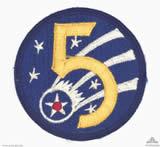
Army units that served in Australia included the 41st (Sunset) Infantry Division, the 32nd Infantry Division [arrowhead], and the 5th Air Force, US Army Air Force.
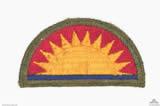
Army units that served in Australia included the 41st (Sunset) Infantry Division, the 32nd Infantry Division [arrowhead], and the 5th Air Force, US Army Air Force.
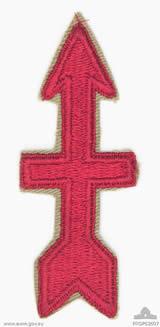
Army units that served in Australia included the 41st (Sunset) Infantry Division, the 32nd Infantry Division [arrowhead], and the 5th Air Force, US Army Air Force.
Lester Culp of Oregon joined the US Army in 1939. By the time America entered the war he was an experienced non-commissioned officer. In late 1941 the 41st (Sunset) Infantry Division was sent to Australia.After training in Puckapunyal and Rockhampton the 41st was sent to Papua. Like many Allied soldiers, Culp contracted malaria and dengue fever and in July returned to Rockhampton to recover. This is the uniform he wore at the time of his discharge in 1945.US uniforms, with their better fabric and cut and bright buttons and badges, sometimes caused envy among many Australian soldiers.
Sergeant Horace Mills of Werris Creek, New South Wales, joined the AIF at the age of 35 in April 1940. He served in North Africa on the staff of 9th Division headquarters.The 9th Division successfully defended the port of Tobruk in Libya in 1941 and played a major role in the Allied victory at El Alamein in Egypt the following year. The shape of the identifying unit colour patches of the 9th Division were changed to a “T” in 1942 in memory of their victory at Tobruk against the Italians and Germans. The colour patch of Sergeant Mills’s unit is stitched to the puggaree hatband of this slouch hat and the sleeves of his tunic.Mills was discharged from the army after his return from the Middle East.
Sergeant Horace Mills of Werris Creek, New South Wales, joined the AIF at the age of 35 in April 1940. He served in North Africa on the staff of 9th Division headquarters.The 9th Division successfully defended the port of Tobruk in Libya in 1941 and played a major role in the Allied victory at El Alamein in Egypt the following year. The shape of the identifying unit colour patches of the 9th Division were changed to a “T” in 1942 in memory of their victory at Tobruk against the Italians and Germans. The colour patch of Sergeant Mills’s unit is stitched to the puggaree hatband of this slouch hat (above) and the sleeves of his tunic (below). Mills was discharged from the army after his return from the Middle East.
American gas masks like this became available for purchase by the Australian public later in the war. Ironically, the supply of gas masks did not reach sufficient levels to meet predicted demands in the event of an enemy air offensive until after the raids on northern Australia had all but finished.
American gas masks like this became available for purchase by the Australian public later in the war. Ironically, the supply of gas masks did not reach sufficient levels to meet predicted demands in the event of an enemy air offensive until after the raids on northern Australia had all but finished.

Designed for those who had medical conditions which precluded the wear of a normal respirator, these helmets were issued in Britain during the Blitz of 1940. They did not become available in Australia until much later in the war, by which time the threat of gas attack had passed.
Anzac Day banner carried by veterans of the Manunda
Every year, on Anzac Day, Australians gather to commemorate the sacrifice of our servicemen and women in war. Veterans muster and march behind the banners that carry the symbols and battle honours of their unit. Those who served on the hospital ship Manunda in Darwin when Australia was first under attack, and on its later service in the Pacific, marched behind this banner on Anzac Day parades in Sydney from the 1950s until recently. They marched in memory of the thousands of medical personnel and patients who served in, or suffered on, Manunda between 1942 and 1946.







